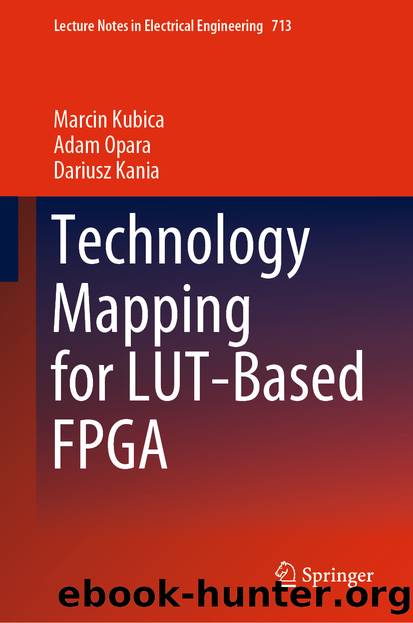Technology Mapping for LUT-Based FPGA by Marcin Kubica & Adam Opara & Dariusz Kania

Author:Marcin Kubica & Adam Opara & Dariusz Kania
Language: eng
Format: epub
ISBN: 9783030604882
Publisher: Springer International Publishing
(8.2)
More advanced exemplary representations of a PMTBDD diagram for the multioutput function f0f1f2 is presented in Fig. 8.11. In each case the leaf of an MTBDD diagram placed on the left corresponds to the PMTBDD representation placed on the right. For example, the leaf 111f0,f1,f2, correlates with a subdiagram of the form [2].
Fig. 8.11Examples of representations of leaves in the diagrams MTBDD and PMTBDD for a multioutput function f0, f1, f2. (see Footnote 1) [2]
Replacing MTBDD leaves with nonterminal nodes gives the possibility of processing the entire diagram using the same procedure. Thus, a separate procedure to process MTBDD leaves is not needed. By appropriately specifying the expressions that describe subdiagrams that replace MTBDD leaves (expression 8.1), merging several diagrams into the diagram of multioutput function may be performed using a standard OR operation (see Footnote 1) [2].
The process of merging ROBDD diagrams into one PMTBDD will be presented using the example of the function f0â=ââx0â+âx1, f1â=ââx0·âx1. With two ROBDD diagrams for f0 and f1 (Fig. 8.12), additional variables f0â², should be introduced and appropriate additional variable should be multiplied by a function. After multiplying, the expressions p0â=â·(x0â+ââx1) and p1â=â·âx0·âx1, whose diagrams are presented in Fig. 8.12c, d, will be created. PMTBDD diagrams, similar to MTBDD diagrams, in special cases may represent single functions. To simplify the presented example, PMTBDD diagrams present a possibility in Fig. 8.12c, d. Each of the two PMTBDD diagrams represent a multioutput function; however, only one function exists in each multioutput function. All nodes below the nodes related toâx1 are treated as MTBDD leaves. Because there is only one single output function, below levelâx1 only one level of nodes related to additionally introduced variables may exist (see Footnote 1) [2].
Fig. 8.12Process of transforming the diagrams: a, b ROBDD, c, d PMTBDD (see Footnote 1) [2]
Download
This site does not store any files on its server. We only index and link to content provided by other sites. Please contact the content providers to delete copyright contents if any and email us, we'll remove relevant links or contents immediately.
| Automotive | Engineering |
| Transportation |
Whiskies Galore by Ian Buxton(41525)
Introduction to Aircraft Design (Cambridge Aerospace Series) by John P. Fielding(32885)
Small Unmanned Fixed-wing Aircraft Design by Andrew J. Keane Andras Sobester James P. Scanlan & András Sóbester & James P. Scanlan(32570)
Craft Beer for the Homebrewer by Michael Agnew(17930)
Turbulence by E. J. Noyes(7696)
The Complete Stick Figure Physics Tutorials by Allen Sarah(7135)
Kaplan MCAT General Chemistry Review by Kaplan(6592)
The Thirst by Nesbo Jo(6432)
Bad Blood by John Carreyrou(6271)
Modelling of Convective Heat and Mass Transfer in Rotating Flows by Igor V. Shevchuk(6219)
Learning SQL by Alan Beaulieu(6031)
Weapons of Math Destruction by Cathy O'Neil(5825)
Man-made Catastrophes and Risk Information Concealment by Dmitry Chernov & Didier Sornette(5644)
Digital Minimalism by Cal Newport;(5388)
Life 3.0: Being Human in the Age of Artificial Intelligence by Tegmark Max(5182)
iGen by Jean M. Twenge(5158)
Secrets of Antigravity Propulsion: Tesla, UFOs, and Classified Aerospace Technology by Ph.D. Paul A. Laviolette(4984)
Design of Trajectory Optimization Approach for Space Maneuver Vehicle Skip Entry Problems by Runqi Chai & Al Savvaris & Antonios Tsourdos & Senchun Chai(4837)
Electronic Devices & Circuits by Jacob Millman & Christos C. Halkias(4744)
